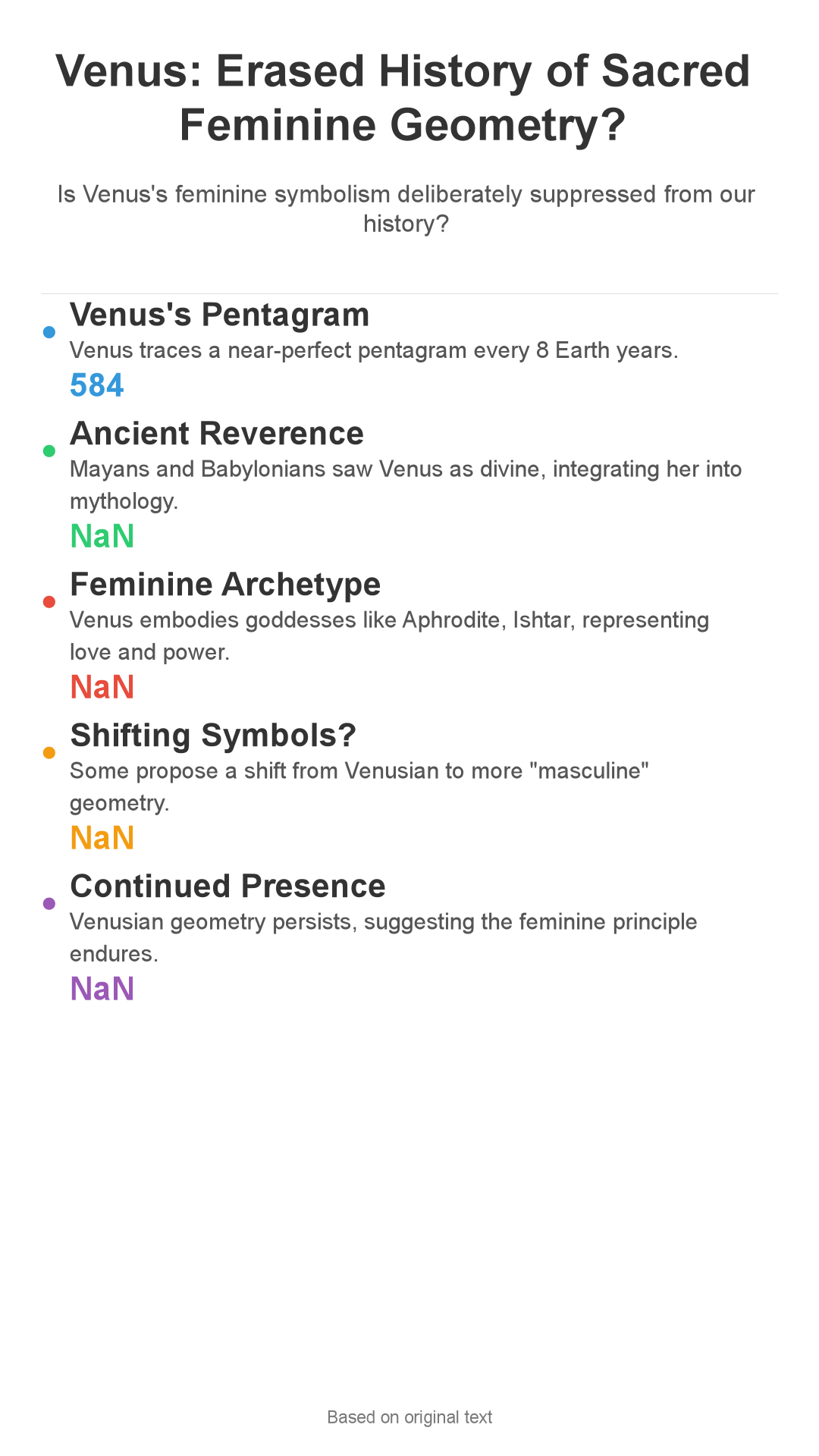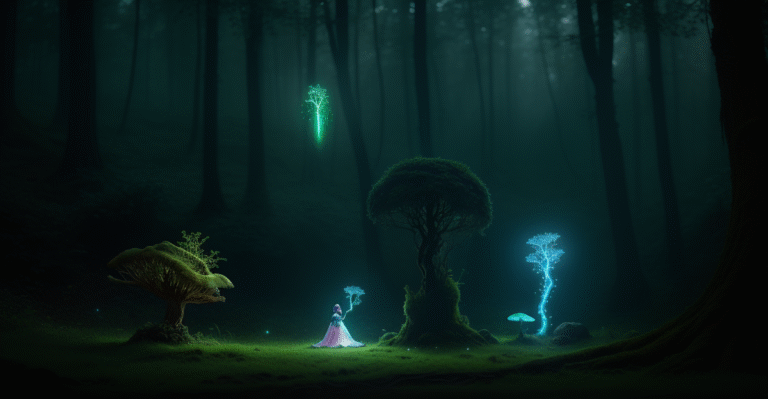
Is Venus whispering forgotten secrets of feminine power across the cosmos? This video delves into th
Ever wondered why sacred geometry seems dominated by circles, squares, and cubes? What if the pentagram, born from Venus’s elegant celestial dance, was once a central symbol, a potent emblem of feminine power deliberately sidelined? Intrigued? Then hit that like button and prepare to explore a cosmic mystery!
The cosmos whispers secrets, and the planets are its storytellers. But is one storyteller’s voice being deliberately silenced? We’re talking about Venus, the planet of beauty, love, and the feminine divine.
The Venus Cycle and its Geometric Significance
Venus, our radiant sister planet, is more than just a pretty face.
Her synodic cycle – the time it takes for her to return to the same position relative to the Sun and Earth – is about 584 days.
Over eight Earth years, Venus paints a near-perfect pentagram in the sky, a five-pointed star that has captivated cultures for millennia.
618. This number, considered by many to be a fundamental constant of the universe, appears throughout nature, from seashells to tree branches.
Ancient Reverence for Venus
Ancient civilizations were keenly aware of this celestial ballet. The Mayans meticulously tracked Venus, integrating her cycles into their calendars and mythology.
They associated Venus with Quetzalcoatl, the feathered serpent deity embodying both masculine and feminine principles. The Babylonians revered Venus as Ishtar, the powerful goddess of love, war, and fertility.
These cultures saw Venus not merely as a planet, but as a potent, divine presence.
Venus as a Feminine Archetype: Goddesses and Symbolism
Venus is more than just geometry; she embodies powerful archetypes. The planet is inextricably linked to feminine deities across diverse cultures, each representing different facets of the feminine principle.
Goddesses of Venus
Aphrodite in Greece, Venus in Rome, Ishtar in Babylon, Inanna in Sumer, Quetzalcoatl in Mesoamerica – all these goddesses share deep connections to the planet Venus.
They represent love, beauty, fertility, and even war, showcasing the complex and multifaceted nature of the feminine divine. These goddesses were not passive figures; they were powerful forces shaping the world.
Symbols of Venus
The rose, the shell, and the dove are all potent symbols associated with Venus and her associated goddesses.
The rose, with its intricate petals spiraling according to the Golden Ratio, mirrors the geometric beauty of Venus’s cycle. The shell, often linked to birth and the sea, represents fertility and the feminine womb.
The dove, a symbol of peace and love, embodies the harmonious aspects of Venusian energy.
The Feminine Principle in Cosmology
In many ancient cosmologies, the feminine principle was seen as the creative force, the womb from which the universe was born.
This principle was often associated with water, the element of creation and fluidity.
Venus, with her watery associations (think of Aphrodite’s birth from sea foam), may have played a crucial role in these cosmologies, representing the generative power of the universe.
Sacred Geometry: From Divine Proportion to Suppressed Knowledge?
Sacred geometry, the belief that geometric forms hold spiritual significance, boasts a rich history stretching back to ancient Egypt and Greece. But has its narrative been subtly altered, shifting away from feminine-aligned symbols like the pentagram?
A History of Sacred Geometry
From the pyramids of Giza to the Parthenon in Athens, sacred geometry has been used to create structures that resonate with harmony and balance.
The Golden Ratio, a key element in the Venus pentagram, was central to many of these designs. However, as societies evolved, certain symbols and geometric forms gained prominence, while others faded from view.
Shifting Symbols: Masculine vs.
Some researchers propose that there was a deliberate shift away from Venus-centric geometry towards symbols more often associated with “masculine” principles.
The cube, representing stability and structure, and the sphere, representing unity and perfection, became dominant in many Western esoteric traditions.
Was the pentagram, with its feminine associations, deliberately sidelined to lessen the perceived influence of female power?
Motivations Behind Suppression
The potential motivations behind this alleged suppression are complex and multifaceted. Patriarchal structures, seeking to consolidate power, may have sought to diminish the influence of feminine symbolism.
Control of knowledge, especially esoteric knowledge, was often a tool used to maintain social hierarchies.
Evidence and Counterarguments: Examining the Claims of Suppression
While the idea of a deliberate suppression of Venusian geometry is compelling, it’s essential to critically examine the evidence and consider alternative interpretations.
The Continued Presence of Venusian Geometry
Despite the potential shift towards more “masculine” symbols, Venusian geometry hasn’t vanished entirely.
The pentagram continues to appear in esoteric traditions, art, and architecture, often representing protection, magic, and the five elements.
Its continued presence suggests that the feminine principle, while perhaps marginalized in some contexts, has never been completely erased.
Counterarguments and Alternative Interpretations
It’s crucial to consider alternative interpretations of historical events and symbolism.
The shift towards different geometric forms may not have been a deliberate act of suppression, but rather a natural evolution of cultural emphasis and philosophical priorities.
Different cultures and time periods may have simply prioritized different aspects of the universe, leading to a shift in symbolic representation.
Intentional Suppression vs. Cultural Shift
Differentiating between intentional suppression and natural shifts in cultural emphasis is paramount.
While it’s possible that some individuals or groups actively sought to diminish the influence of feminine symbolism, it’s equally plausible that the shift was a more gradual and unconscious process, driven by complex social, political, and economic factors.
Conclusion
We’ve journeyed through the geometric dance of Venus, her profound connection to feminine deities, and the intriguing idea that feminine symbolism in sacred geometry may have been suppressed. We’ve explored the evidence supporting this claim, as well as the counterarguments that point to a more nuanced interpretation of history.
The story of Venus and sacred geometry is a complex and captivating one, brimming with intrigue, symbolism, and potentially, a forgotten chapter in the history of female power.
By re-evaluating the role of the feminine in our understanding of the universe, we may unlock new insights into the very nature of reality. What are your thoughts?
Could Venus hold a key to a more balanced understanding of sacred geometry and the universe?
If you enjoyed this deep dive, don’t forget to subscribe and hit the notification bell for more explorations into the weird and wonderful corners of the internet!

Enjoyed this? Check out our YouTube channel for video versions!
Enjoyed this? Check out our YouTube channel for video versions!



